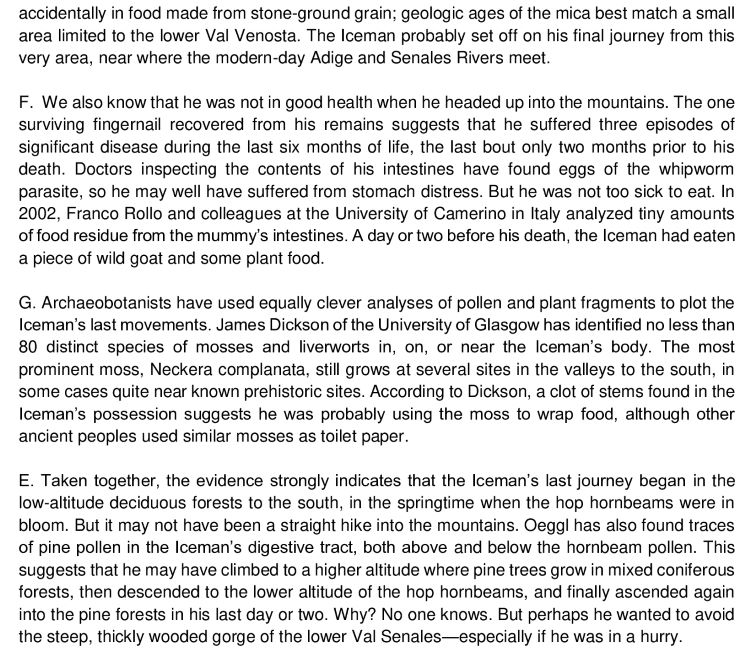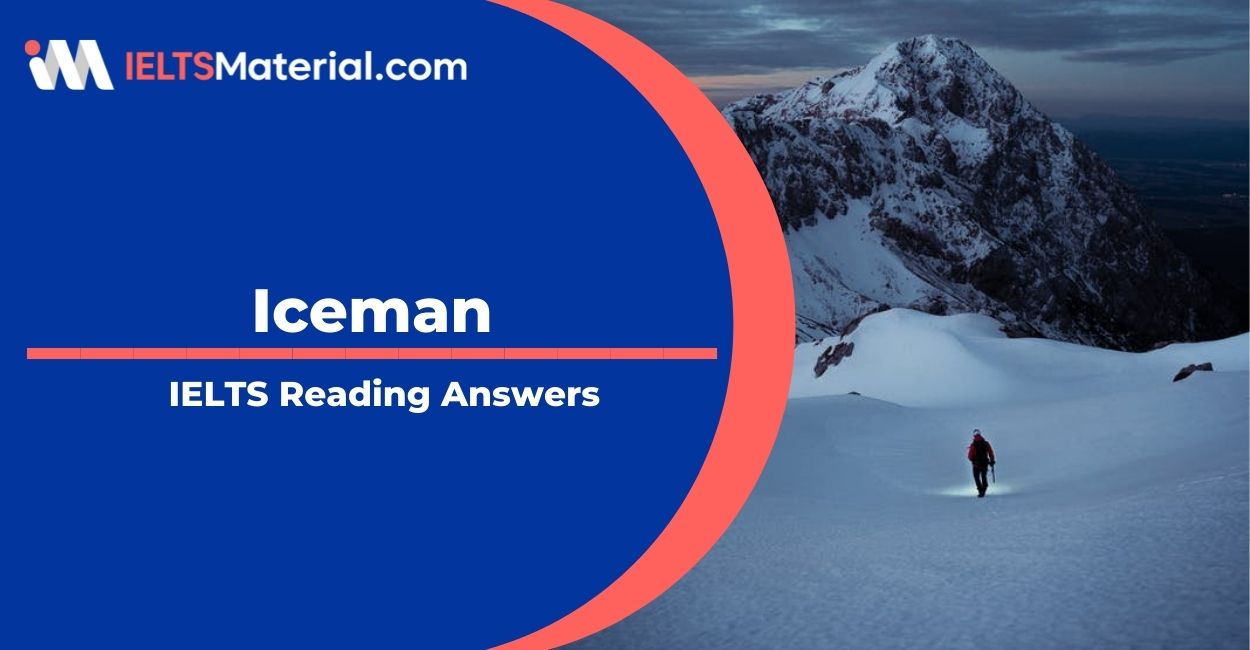Iceman- IELTS Reading Passage
8 min read
Updated On
-
Copy link
Table of Contents

Limited-Time Offer : Access a FREE 10-Day IELTS Study Plan!
Reading Passage
Iceman


QUESTIONS
Questions 1-5
NB you may use any letter more than once
1 The last area in which the iceman might live and stay.
2 A mass of a special plant was discovered and used to analyze the iceman’s movements.
3 A scientist analyzes the iceman’s last hike depending on pollen.
4 The time and area the iceman was found.
5 The iceman’s body had been out of condition for months before his death.
Questions 6-9
Do the following statements agree with the information given in Reading Passage 1?
In boxes 6-9 on your answer sheet, write
TRUE if the statement agrees with the information
FALSE if the statement contradicts the information
NOT GIVEN if there is no information on this
6 According to the author, there must be another complete human corpse older than the iceman.
7 The Iceman might be the leader of his society, and he was very rich.
8 Scientists guessed the iceman’s information perfectly, and finally got the real cause of his death.
9 By testing the iceman’s body, we know where he came from
Questions 10-13
10 The iceman has been placed in a …………………… room since 1998.
11 The iceman might get ……………………, for eggs of the whipworm parasite were found in his gut.
12 There are a variety of mosses and liverworts found around the iceman such as ……………………
13 The route of the iceman’s last movement might not be ……………………
Reading Answers
1 Answer: E
Question type: Matching Information
Answer location: Paragraph E, last line
Answer explanation: The last line of paragraph E states that the geologic ages of the mica best match a small area limited to the lower Val Venosta. The Iceman probably set off on his journey from this very area, near where the modern-day Adige and Senales Rivers meet. These lines indicate the last area in which the iceman might live and stay. So, the answer is E.
2 Answer: G
Question type: Matching Information
Answer location: Paragraph G
Answer explanation: The initial lines of Paragraph G states that Archaeobotanists have used equally clever analyses of pollen and plant fragments to plot the Iceman’s last movements. These lines suggest a mass of a special plant was discovered and used to analyze the iceman’s movements. Thus, the answer is Paragraph G.
3 Answer: H
Question type: Matching Information
Answer location: Paragraph H, line 4
Answer explanation: The 4th line of paragraph H states that Oeggl has also found traces of pine pollen in the Iceman’s digestive tract, both above and below the hornbeam pollen. This suggests that he may have climbed to a higher altitude where pine trees grow in mixed coniferous forests, then descended to the lower altitude of the hop hornbeams, and finally ascended again into the pine forests in his last day or two. These lines reveal that a Scientist, Oeggl, has analyzed the iceman’s last hike depending on the pollen. Thus, the answer is Paragraph H.
4 Answer: B
Question type: Matching Information
Answer location: Paragraph B
Answer explanation: The introductory lines of paragraph B illustrates, “Since hikers discovered his mummified corpse in 1991 in a rocky hollow high in the Otztal Alps on Italy’s border with Austria, scientists have used ever more sophisticated tools and intellectual cunning to reconstruct the life and times of the Iceman, the oldest intact member of the human family. ” We can deduce from these lines that the time and area of the iceman was found, i.e, the hikers discovered the iceman’s mummified corpse in 1991 in a rocky hollow high in the Otztal Alps. Thus, the answer is Paragraph B.
5 Answer: F
Question type: Matching Information
Answer location: Paragraph F
Answer explanation: The initial lines of paragraph F illustrate that he was not in good health when he headed up into the mountains. The one surviving fingernail recovered from his remains suggests that he suffered three episodes of significant disease during the last six months of life, the last bout only two months prior to his death. We understand that paragraph F explains how the Iceman was suffering from illness before his death and these lines indicate how the iceman’s body had been out of condition for months before his death. So, the answer is paragraph F.
6 Answer: No
Question type: Yes/No/ Not Given
Answer location: Paragraph B
Answer explanation: The initial lines of paragraph B reveal that some hikers discovered his mummified corpse in 1991 in a rocky hollow high in the Otztal Alps on Italy’s border with Austria, scientists have used ever more sophisticated tools and intellectual cunning to reconstruct the life and times of the Iceman, the oldest intact member of the human family. These lines indicate the time and area where the iceman’s corpse was found. Thus, the statement contradicts the information, so, the answer is No.
7 Answer: Not Given
Question type: Yes/No/ Not Given
Answer location: Paragraph B, line 4
Answer explanation: In the 4th line of paragraph B, the author states that he was a small, sinewy, and, for his times, rather an elderly man in his mid-40s. Judging from the precious, copper-bladed ax found with him, we suspect that he was a person of considerable social significance. These lines indicate that the author is defining what the Iceman looked like. But there’s no mention that he might be a leader of his society or that he was very rich. Thus, the answer is Not Given.
8 Answer: No
Question type: Yes/No/ Not Given
Answer location: Paragraph F
Answer explanation: The author reveals in paragraph F that Iceman was not in good health when he headed up into the mountains. The one surviving fingernail recovered from his remains suggests that he suffered three episodes of significant disease during the last six months of life, the last bout only two months prior to his death. Doctors inspecting the contents of his intestines have found eggs of the whipworm parasite, so he may well have suffered from stomach distress. But he was not too sick to eat. These lines indicate that the Iceman’s body was out of condition as he suffered from three episodes of major diseases before his death. Therefore, the statement contradicts the information, so, the answer is No.
9 Answer: Not Given
Question type: Yes/ No/ Not Given
Answer location: Paragraph C, line 2
Answer explanation: The 2nd line of paragraph C reveals that during the 16 years that scientists have poked, prodded, incised, and x-rayed his body, they have dressed him up in speculations that have not worn nearly as well as his rustic garments. At one time or another, he has been mistakenly described as a lost shepherd, a shaman, a victim of ritual sacrifice, and even a vegan. These lines indicate that the iceman’s body was tested (poked, prodded, incised, and x-rayed). The scientists even dressed him up in rustic garments and have mistaken him for a lost shepherd or a shaman, or a victim of ritual sacrifice. However, there’s no reference to the fact that by testing the iceman’s body, his whereabouts were known. Thus, the answer is Not Given.
10 Answer: refrigerated high-tech
Question type: Sentence Completion
Answer location: Paragraph E
Answer explanation: The introductory line of paragraph E states that the object of all this intense scientific attention is a freeze-dried slab of human jerky, which since 1998 has resided in a refrigerated, high-tech chamber in the South Tyrol Museum of Archaeology in Bolzano, Italy. These lines illustrate that the Iceman has resided in a refrigerated high-tech chamber since 1998 in the museum of Archeology. Thus, the answer is refrigerated, high-tech.
11 Answer: stomach distress
Question type: Sentence Completion
Answer location: Paragraph F line 4
Answer explanation: Line 4 of paragraph F reveals that doctors inspecting the contents of his intestines have found eggs of the whipworm parasite, so he may well have suffered from stomach distress. But he was not too sick to eat. We can deduce from these lines that the doctors inspected the iceman’s body where they found eggs of the whipworm parasites, leading him to suffer from stomach distress. Thus, the answer is Stomach distress.
12 Answer: neckera complanata
Question type: Sentence Completion
Answer location: Paragraph G, line 4
Answer explanation: The 4th line of paragraph G states that the most prominent moss, Neckera Complanata, still grows at several sites in the valleys in the south, in some cases quite near known prehistoric sites. These lines illustrate that there were a variety of liverworts and mosses found around the Iceman’s body such as the Neckera Complanata. So, the answer is Neckera complanata.
13 Answer: straight
Question type: Sentence Completion
Answer location: Paragraph H
Answer explanation: Paragraph H explains that taken together, the evidence strongly indicates that the Iceman’s last journey began in the low-altitude deciduous forests to the south, in the springtime when the hop hornbeams were in bloom. But it may not have been a straight hike into the mountains. We can deduce that the iceman’s last journey began in the low altitude deciduous forest to the south, but there wouldn’t be a straight hike into the mountains. Thus, the answer is straight.
Check More IELTS Reading Answers

Start Preparing for IELTS: Get Your 10-Day Study Plan Today!
Recent Articles

Kasturika Samanta

Kasturika Samanta


Kasturika Samanta




Post your Comments